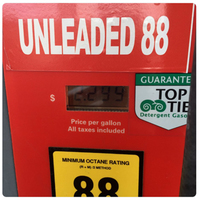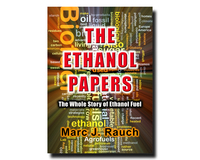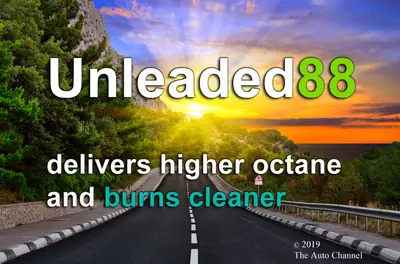Explaining Unleaded 88 Gasoline (E15 - 15% Ethanol)
Turn About is Fair Play: Ethanol Industry Zings the Oil Industry
with Brilliant Branding Strategy (Not Sponsored)
with Brilliant Branding Strategy (Not Sponsored)
By Marc J. Rauch
Exec. Vice President/Co-Publisher
THE AUTO CHANNEL
FIRST, A LITTLE BACKGROUND
 Marc J. Rauch |
A hundred years ago, as internal combustion engine vehicles (automobiles, airplanes, and boats) started requiring a better gasoline to eliminate engine knock in high compression engines, ethanol was the only practical additive. Of course, ethanol could have been used by itself to replace gasoline, but then the rich and powerful oil industry would hardly agree to that.
Top automobile people and scientists (i.e., Kettering, Midgely, Ford, Otto, Ricardo, Edison, Bell, Hale, Christensen, and Thompson) all believed that ethanol was the superior fuel..."the fuel of the future."
In the early 1920's, General Motors top engineers invented leaded gasoline by adding tetra-ethyl lead (TEL). When GM combined their patents with similar patents owned by Standard Oil and DuPont, you had three of the largest and most influential companies in the world wielding their financial and political power to assure the unrivaled success of leaded gasoline.
There was a problem with using TEL in gasoline: it's extremely dangerous. Inhaling and touching TEL to bare skin can, and did, kill people. Some victims didn't die, they just went insane. Workers at the plants manufacturing leaded gasoline referred to the TEL-gasoline concoction as "looney gas." There were many attempts to outlaw or limit the use of TEL, but the financial muscle of the TEL proponents was too much to overcome.
In order to disguise the dangerous nature of leaded gasoline - to hoodwink the public and less knowledgeable politicians - Standard Oil branded it "Ethyl." This was a near perfect answer because it combined a portion of the formal name of the ingredient, giving it some connection, and it also took advantage of the similarity to "ethanol," which some people understood to be the original and safe way to mitigate engine knock.
Over the years, the petroleum oil industry has relied on semantic word play and creative branding several times to dupe the public and enhance acceptance of their products. The story of "ethyl" is one example. Another less known example is the term "fossil fuels." The term was a creation of Standard Oil (perhaps old John D, himself), and introduced at an international scientific convention in the late 1800's. One of the reasons for the gathering of scientists was to establish common unanimity in words, terms, definitions, and processes. Standard Oil suggested "fossil fuels" as a way to add some romance and nobility to the issue. In fact, fossil fuels are not fossil fuels as they do not derive from ancient decayed organisms. Dinosaurs did not die to give us engine fuel. Coal and petroleum oil come from inert minerals. Tom Quinn, CEO and president of E-Fuel Corporation, points out that Saturn's moon Titan has hundreds of times more liquid hydrocarbons than all the known oil and natural gas reserves on Earth, yet there is absolutely no evidence that dinosaurs ever existed on Titan. The proper term for these fuels is "abiotic fuels."
In any event, "fossil fuels" was a very clever marketing gimmick.
Still another branding deception that's been used by the oil industry - one that I've written about on several occasions - is the industry's use of BTU (British Thermal Units) rating to portray gasoline as being superior to ethanol and other potential internal combustion engine fuels. BTU was created as a way to describe and rank a fuel's capability to heat water. The purpose of heating the water is to create steam for steam-powered engines (the last steam-powered cars sold in America were about 100 years ago). Today, our standard engines are Internal combustion engines, which are not powered by hot water or steam - if your internal combustion engine is producing steam, there's something very wrong.
It is a fact that petroleum diesel fuel and gasoline do have higher BTUs than ethanol. However, citing the BTU ranking is merely a coincidental deception. A gasoline-powered engine using gasoline usually produces greater mileage output than when ethanol is used simply because the characteristics of the engine are optimized to run on gasoline. The same engine optimized to run on ethanol will provide equal or better mileage, despite the lower "energy content" of ethanol. So while it's true that gasoline has more BTUs than ethanol, and that petroleum diesel fuel has more BTUs than bio-diesel, the energy content rating is irrelevant. (For more details about BTUs and engine fuels read The Irrelevance Of BTU Rating)
THE BRILLIANCE OF UNLEADED 88 GASOLINE
 |
Recently, some ethanol organizations and friendly fuel retailers have begun using "Unleaded 88" as a way to brand E15 fuel. It's a brilliant move because it helps to diffuse the noxious and obnoxious anti-ethanol myths* invented and spread by the oil industry to denigrate ethanol. (Read the Growth Energy press release by CLICKING HERE.)
You could say that Growth Energy and other ethanol proponents have taken a page right out of the oil industry's playbook...except for one thing: Labeling E15 as Unleaded 88 Gasoline is an accurate, benign statement. "Unleaded 88" isn't used to hide the deadly nature of anything. Unleaded 88 Gasoline is as advertised: It does not contain tetraethyl lead, it is an 88 octane fuel. You can't drink Unleaded 88, you shouldn't engage in recreational inhalation of it, and you shouldn't wash your hands in it, but that's because of the gasoline and aromatic components, not the ethanol.
By comparison, if the oil industry was similarly truthful, leaded gasoline would have been branded "Poison," not "Ethyl." Gasoline with MTBE would have been branded "Reformulated Poison." Gasoline without ethanol (E0) that contains added benzene, toluene, and/or xylene to boost octane and reduce engine knock, should be branded "SUPER Poison."
By the way, there's something that I forgot to mention in the "Background" section above: Tetraethyl lead was extremely corrosive. To reduce TEL's corrosive characteristics, the industry added another chemical called ethylene bromide. Ethylene bromide is also deadly to humans. Therefore, to be accurate, leaded Ethyl gasoline could have been called "Double Poison," and advertised as "Now with twice the ingredients to sicken or kill humans!"
The issue of Unleaded 88 Gasoline has come-to-the-fore in the last week or so because of some articles feigning confusion over the labeling, as if the public will be left out on the perch in a precarious predicament. To me, there's no doubt that the false alarms are instigated by American Petroleum Institute or one of their derivative fake affiliates. One such article - in a Q&A format - was published by The Gazette news organization, written by Frank Schultz, a crime reporter. (Sure seems like a strange reporting assignment choice to me.)
Mr. Schultz received significant assistance from Nick Jarmusz, a spokesman for AAA. Although I generally respect AAA, at least in matters related to traffic statistics and travel prognostication, they have a long history of providing false or misleading information about ethanol. This article is a perfect example of the misinformation I'm talking about. It misstates everything, from ethanol subsidies (there is no ethanol subsidy) to the ridiculous claims that E15 can unduly harm an internal combustion engine. The article doesn't say how the engine can be damaged, it just makes the same old fallacious empty-headed Big Oil claim.
Ethanol is compatible with more engine parts and components than gasoline and the aromatics (benzene, toluene, and xylene) that are used in place of ethanol. Wear and tear is normal in an internal combustion engine; wear and tear is normal in any multi-part organism or mechanical device...and it is normal regardless of the 'fuel' used. Corrosion of parts is also a normal occurrence, but incidence of corrosion in an internal combustion engine and fuel system is more likely due to gasoline and aromatics than to ethanol. (If you doubt this then read "Why Do Small Engines Suffer From Ethanol Problems?" and check out all the chemical compatibility data bases and video demonstrations included in the article.)
Geoff Cooper, president and CEO of Renewable Fuels Association, wrote an excellent rebuttal to the Schultz/Jarmusz Gazette article. Geoff correctly sets forth the extensive EPA testing and approval of E15 in all gasoline-powered cars, trucks, vans manufactured since 2001.
But the testing and approval story is actually bigger than just the EPA's results because Ricardo Laboratories (probably the world's most respected private laboratory dealing with fuels) has stated that E15 is safe for all gasoline powered vehicles produced since the mid-1990's.
Furthermore, E15 and higher ethanol-gasoline blends have been safely and economically used in gasoline-powered vehicles and power equipment in Brazil and Europe for decades (See: "The Hypocrisy of Big Oil and API"). If a common brand-named lawn mower and passenger vehicle of any year can safely use E27 in Brazil (and they can), then they sure-as-shooting can use E15 and higher in North America, regardless of what the EPA says.
The information contained in the Gazette article also includes some out-of-context confusing gibberish related to detergents and octane levels in gasoline. Detergents are needed in gasoline because of gasoline's inefficient burning. This is the cause of the debris that results in all the crud/goo/gunk/crap that can build up in an engine. Ethanol does not cause this problem. Ethanol helps to clean up the mess, as well as prevent the build-up after an engine has been cleaned. Gasoline that contains ethanol needs less or even no detergents. The solvent characteristic of ethanol is another benefit of ethanol, which does happen to have a substantially higher octane level than regular ethanol-free gasoline. However, premium ethanol-free gasoline, which has a higher octane rating than regular ethanol-free gasoline (91 vs. 87 respectively) would also need a detergent additive to combat the debris build-up, so the reason to use an gasoline-ethanol blend goes beyond the issue of octane.
Mr. Jarmusz states that a higher octane fuel provides no performance benefit to an engine designed to operate on a lower octane fuel. This is essentially correct, but it's beside the point because using a higher octane fuel will also not have any detrimental effect on an engine designed to operate on a lower fuel. In my opinion, bringing up the subject is akin to Groucho Marx' on-screen complaint that a restaurant's "ice isn't cold enough" - in other words, it's done just for effect as a piling-on tactic.
Moreover, newer vehicle engines are requiring higher octane fuels to meet environmental goals, so Unleaded 88 can address this need in an economical way.
The discussion of octane levels does give me the opportunity to expose yet another way that the oil industry rips off consumers.
E10 should be a blend of roughly 90% gasoline (87 octane) and 10% ethanol (113 octane). If you were 'splash blending' the fuel yourself - that is to say, you pumped 9 parts E0 gasoline into your tank and then moved to another pump to dispense 1 part E100, you would have a blend that is 89 octane (which is equal to a more expensive mid-grade fuel). However, the oil industry intentionally dumbs down the gasoline in E10 by using less expensive 84 octane gasoline mixed with 113 octane ethanol. The problem with this is that a vehicle designed to run on 87 octane gasoline is optimized to run on the characteristics of 87 octane gasoline, not 84 octane gasoline. It's a given that the ethanol will have different ignition characteristics than 87 octane gasoline, which would be expected to produce fewer miles per gallon. But the 84 octane gasoline will likely also generate fewer miles per gallon than 87 octane. This can worsen the mileage difference between 87 octane E0 and E10, making it appear that E10 is that much more inferior to E0. In other words, E10 formulated with 87 octane instead of 84 octane could/should provide better MPG. Unfortunately, this would require straight-shooting from the oil industry.
By the way, the wholesale cost of E100 can be as low as half the rack (wholesale) price of 87 octane regular E0 gasoline, and sometimes even less. The rack price of 84 octane regular E0 gasoline can be 10 to 15 cents per gallon less than the 87 octane gasoline. This all means that the oil industry is nickel and diming us every step of the way, along side of their untrue attacks on ethanol.
RECAP
Unleaded 88 Gasoline (E15) can be safely and economically used in all internal combustion engines regardless of year of manufacture. This is proven by Brazil's decades long use of E15, E25, and now E27. They have the same engines and fuel systems as those available in the U.S. In addition, E15 to E30 was used throughout Great Britain from the 1920's to the 1970's. This is also true of other countries such as France and Germany.
I understand that there can be a manufacturer warranty issue with using E15 and higher ethanol level fuel in some engines. If you have a vehicle or power equipment that tells you not to use a particular blend level because it can void your warranty, and you're concerned about this, THEN DON'T USE THE FUEL, USE ONLY THE RECOMMENDED FUEL...and wait until the warranty is expired to experiment. For vehicles and power equipment that is no longer under warranty, use whatever blend you wish. Start low, increase blend levels slowly over numerous fill-ups. If you get to a point where you believe that the engine is not operating at peak performance, back off until you find the sweet spot (the best ethanol-gasoline blend level for your machine).
If you think I'm incorrect and that ethanol will be unduly harmful to a particular type of rubber, plastic, or metal component, send me the name of the material and let me investigate it (email me at marc@theautochannel.com). I'm as happy to provide correct, substantiated warning information as I am to tell you that ethanol is safe. If there is a common engine component that is more susceptible to ethanol corrosion than to gasoline or aromatic corrosion, it's no skin off my nose to publicly acknowledge it.
The petroleum oil industry is not the consumers' friend. They sell poison. They lie. They are responsible for untold millions of deaths and illnesses. They are the cause of wars and most international terrorism. There is no "American" oil industry. There is a self-interested industry that may have a headquarters office in America. Executives in the biggest oil companies have proven time and again that they will sell out our country and fellow citizens for their own gain. This is true of all oil companies and the countries that think they have a "domestic oil industry."
As an American, I would rather have my fuel money go to American farmers than to foreign dictators and terrorist regimes. If I was Australian, British, French, Mexican, New Zealand, etc., I would say the same thing about that respective country's farmers.
 |
If you like to know more about ethanol fuel, LOTS MORE, read my 641-page book "THE ETHANOL PAPERS." It is available online for FREE by CLICKING HERE.
*Oil industry myths (lies & gross distortions) to combat Ethanol:
• Ethanol sucks water right out of the air
• Food vs fuel - prices and food availability
• Ethanol damages engines
• Creates greater emissions problems
• Has lower energy content BTU – lower MPG
• EROEI - Ethanol production is energy negative
• Requires too much water for production
• Chemical fertilizer creating environmental nightmare
• Ethanol gets unfair, wasteful government subsidies
For additional relevant information, read CARB, GM, SoCal Edison and Others Join Forces to Keep California in the Lead of the Great Electric Vehicle Scam.



